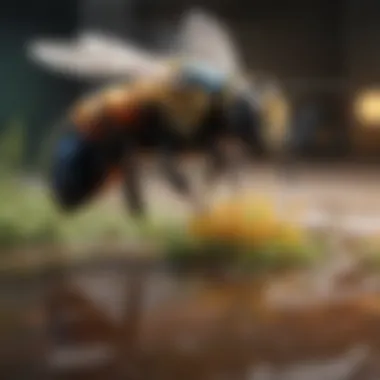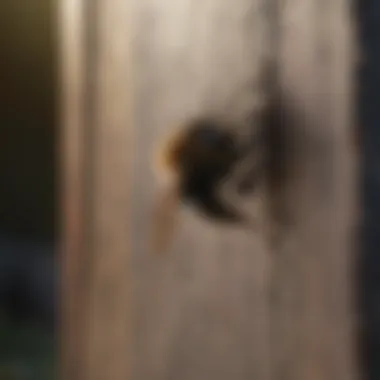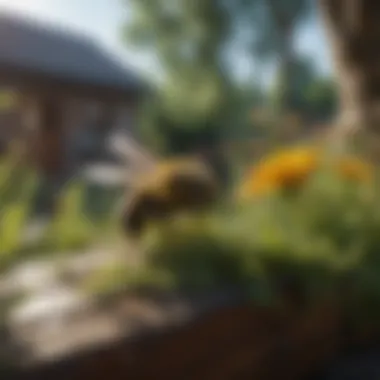Understanding Carpenter Bee Insecticide: A Comprehensive Guide


Intro
Carpenter bees, unlike honeybees, are solitary insects known for their wood-boring habits. They create tunnels in untreated wood, often causing significant structural damage. Understanding how to effectively manage these pests is essential for homeowners aiming to protect their properties. The topic of carpenter bee insecticides encompasses several important aspects, from the chemical properties of the products to the safest methods of application.
The discussion of insecticide options not only pertains to their effectiveness but also focuses on their safety and environmental impact. This balance is vital for those who wish to maintain a garden that remains friendly to pollinators while addressing potential infestations. In this article, we will explore various aspects of carpenter bee insecticides, including their formulations, application strategies, and alternative methods to deter these pests.
Key Points to Discuss
- Chemical Composition: Analyze different insecticides suitable for carpenter bees, focusing on active ingredients and their effectiveness.
- Application Methods: A review of best practices for using insecticides safely and effectively.
- Safety Concerns: Important considerations regarding human and pet safety, as well as environmental implications.
- Alternative Solutions: Discuss eco-friendly methods and practices that can help in managing carpenter bee populations while promoting a healthy garden ecosystem.
It is crucial to provide homeowners and gardening enthusiasts with the extensive knowledge needed to create a sustainable solution for carpenter bee control. By understanding the complexities of carpenter bee insecticides, readers will be better equipped to make informed decisions in their pest management strategies.
Prolusion to Carpenter Bees
Carpenter bees are a group of wood-boring bees known for their unique nesting behaviors and ecological roles. They are often mistaken for bumblebees due to their similar appearance, yet they have distinct characteristics that set them apart. Understanding carpenter bees is crucial for homeowners and gardeners, especially when dealing with infestations. Their activities can lead to structural damage in wooden structures, including decks, fences, and homes.
In specific areas, properties can become prime targets for these bees. Knowledge of their biology and behavior helps in preventing potential issues. It also assists in making informed decisions regarding pest management solutions.
Once homeowners recognize the signs of carpenter bee activity, they can take steps to mitigate damage. This leads to better preservation of wooden structures and a more balanced garden ecosystem.
Biology of Carpenter Bees
Carpenter bees belong to the family Apidae. They are typically large, with a robust body covered in dense hair. Their coloration can vary, but many exhibit a shiny black surface, particularly on their abdomen. Unlike other bees, carpenter bees do not create hives or colonies. Instead, females bore holes into wood to lay their eggs. The entrance typically appears as a perfectly round hole with a diameter around half an inch.
These bees play an essential role in pollination. They are known to visit various flowering plants, contributing to the overall health of the environment. Female carpenter bees are responsible for nest building. They collect pollen and nectar to provision their young. Males do not contribute to the nesting process; their primary role is to mate with females.
Behavioral Patterns
Carpenter bees are solitary creatures, although some species may nest in close proximity. Males are often observed defending their territory, even though they do not sting. They engage in aggressive behavior when perceived threats are close, creating a misconception of their danger.
The nesting behavior of carpenter bees is quite fascinating. They dig tunnels into the wood, often creating complex structures inside. The entrance is not only a way in and out; it also offers the young a safe environment.
These bees are generally active during the day, especially in warm temperatures. Their preference for certain wood types, like cedar and redwood, influences where they establish their nests. Understanding these patterns helps in predicting infestations and means of control.
"Recognizing the nesting habits of carpenter bees empowers homeowners to take effective preventive measures."
Understanding Insecticides
Understanding insecticides is a vital aspect of managing pest issues, particularly where carpenter bees are concerned. Such knowledge helps homeowners to make informed decisions about pest control options while considering the balance of local ecosystems. Insecticides are designed to either kill or repel specific pest species, but their broader implications must also be understood. The aim is not just to eradicate a problem, but to do so in a way that minimizes harm to non-target species, particularly beneficial insects like pollinators.
Definition and Purpose
Insecticides are chemical or biological substances that are specially formulated to control bugs. Their primary purpose is to manage pest populations that pose threats to human activities, including gardening and structural integrity of homes. By understanding the definitions and purposes of various insecticides, homeowners can select appropriate products for their needs. Additionally, it is essential to recognize that the effectiveness of these substances can vary based on multiple factors, including pest species, application methods, and environmental conditions.
Types of Insecticides
There are several categories of insecticides, each serving unique functions and possessing distinct advantages and disadvantages.
- Synthetic Insecticides: These are chemically engineered products like pyrethroids, which are commonly used due to their rapid effectiveness against many pest species.
- Biological Insecticides: Made from natural organisms, these include products based on bacteria such as Bacillus thuringiensis (Bt). They tend to be selective and less harmful to non-target species.
- Botanical Insecticides: Derived from plants, these insecticides include substances like neem oil. They often provide multiple benefits to plants while minimizing harm to beneficial insects.
- Insect Growth Regulators (IGRs): These products interfere with the development of pests, making it difficult for them to grow and reproduce effectively.
Each type has unique characteristics that can serve various needs, making it crucial for homeowners to research and select the most suitable option for their specific situation.
Carpenter Bee Insecticide: An Overview
In light of the growing awareness regarding ecological balance, many individuals seek alternatives that minimize harm to beneficial insects. An informed choice in carpenter bee insecticides helps not only in combating these pests but also in maintaining a healthy garden ecosystem.
Importance of Carpenter Bee Insecticide
Carpenter bees are often mistaken for bumblebees due to their similar appearance. However, they specifically bore into wood to create nests. This behavior can lead to structural problems. Thus, it becomes essential to choose an appropriate insecticide that effectively targets these bees without undue risk to other wildlife.
Key points covered in this section include:
- The necessity of carpentry bee insecticides in protecting wooden structures
- Recognizing the benefits of targeted insecticides that do not disrupt the local ecosystem
- The role of insecticide choice in long-term pest management strategies


Chemical Composition
Carpenter bee insecticides contain various active ingredients formulated to either kill or repel these bees. Commonly used ingredients include neonicotinoids and pyrethroids, which act on the nervous system of insects. Understanding the chemical makeup can aid in selecting the right product.
Key components include:
- Neonicotinoids: Effective for quick kill but risky to pollinators
- Pyrethroids: Fast-acting, often used in household products
- Insect growth regulators: Disrupt the development of larvae, reducing future populations
When selecting an insecticide, consider not only the effectiveness but also the potential impact on non-target species.
How It Works
The mechanism of carpenter bee insecticides varies according to their chemical composition. Generally, these substances are designed to interfere with the normal functioning of bees.
- Neonicotinoids: They bind to nerve receptors, causing paralysis and death. This process can be quick, often within hours.
- Pyrethroids: They cause an overstimulation of the nervous system, leading to death through convulsions.
- Insect growth regulators: These prevent the bees from reaching maturity, thereby reducing the reproduction rate.
Using insecticides requires diligence and knowledge of application methods. Ensuring it is directed specifically to target areas minimizes the risk to other species.
Understanding the specific components and mechanisms of insecticides highlights the importance of responsible use. The choice of product can dramatically affect not just pest control, but also the overall health of the environment.
Effectiveness of Carpenter Bee Insecticides
Understanding the effectiveness of carpenter bee insecticides is critical for homeowners and gardening enthusiasts. These insecticides serve dual purposes: they not only aid in managing the carpenter bee population but also help create a more hospitable environment for gardens that may be at risk of damage from these wood-boring pests. The effectiveness of these products can depend on various factors including chemical formulation, application methods, and environmental conditions.
Benefits of Effectiveness
- Control: Effective insecticides can significantly reduce the infestation levels, minimizing damage to wooden structures.
- Safety: Most research emphasizes insecticides that pose fewer risks to humans and pets, balancing efficacy with safety.
- Sustainability: Effective manage-ment can lead to a sustainable approach in keeping the bee population in check without harming beneficial pollinators.
The sections that follow delve into the specifics of the effectiveness of carpenter bee insecticides, through comparative studies and long-term impacts. These elements will provide important insights into choosing the right methods for managing these insects.
Comparative Studies
Comparative studies remain essential in evaluating the performance of various carpenter bee insecticides. Research often investigates effectiveness across different formulations, such as pyrethroids and neonicotinoids. A study published in a pest management journal noted that the choice of insecticides affects not only the carpenter bees but also non-target species.
Some key findings include:
- Efficacy of Pyrethroids: Many studies highlight the rapid knockdown effect of pyrethroids. These insecticides tend to work quickly upon contact but may require reapplication.
- Neonicotinoids: These act more slowly but have a longer residual effect. Their impact on non-target species is a growing concern.
It is valuable to note that the effectiveness of an insecticide often depends on timing and application techniques. Research indicates that applying during peak bee activity increases the chances of successful pest management.
Long-Term Impact
The long-term impact of using carpenter bee insecticides warrants examination. It raises important considerations, not just for immediate effectiveness but also for lasting ecological effects. Prolonged use can lead to resistance in pest populations, reducing overall effectiveness over time. Furthermore, studies are increasingly highlighting the potential impacts on local ecosystems.
Some long-term considerations include:
- Resistance Development: Pests may develop resistance to certain formulations, requiring higher doses or different products. This underscores the importance of rotating insecticides.
- Impact on Beneficial Insects: As carpenter bees are important for pollination, it is crucial to consider how insecticides affect those benign species. Less selective products can threaten pollinator populations.
Safety Considerations
Understanding safety considerations when using carpenter bee insecticides is crucial for ensuring the well-being of both humans and the environment. The application of these products can carry risks, so thorough knowledge of potential hazards is necessary for informed decision-making. This section delves into specific risks associated with human exposure, pet safety, and impacts on pollinating insects.
Health Risks to Humans
The use of insecticides can pose various health risks to humans, especially if the products are not applied properly. Common risks include skin irritation, respiratory problems, and even potential long-term health effects from chronic exposure. It is essential to read and follow the instructions provided by manufacturers to mitigate these risks.
Symptoms of exposure may include headaches, dizziness, and difficulty breathing. Long-term exposure to some chemicals found in insecticides has been linked to more severe health issues, including neurological effects and potential carcinogenicity. Thus, homeowners must handle insecticides with care and consider using protective gear, such as gloves and masks, during application. Furthermore, always ensure that children and vulnerable adults are kept away from treated areas until it is safe to re-enter.
Risks to Pets
Pets can also be adversely affected by insecticides. Cats and dogs are particularly vulnerable due to their close interaction with treated surfaces. Ingesting or coming into contact with treated surfaces can result in a range of health issues, from mild gastrointestinal disturbances to severe poisoning in extreme cases. To ensure pet safety, it is advisable to keep animals indoors or away from treated areas until it is deemed safe by product guidelines.
Owners should also be aware that certain ingredients used in insecticides can be harmful when absorbed through the skin or through ingestion of contaminated plants or surfaces. Always choose pet-safe products and consider alternative pest management strategies that minimize risks to animal companions.


Impact on Pollinators
Pollinators play a pivotal role in our ecosystems, particularly in supporting plant reproduction. The use of insecticides, even those marketed as carpenter bee-specific, can have unintended consequences on beneficial insect populations, including honeybees and native pollinators. It is important to recognize that while targeting carpenter bees, the chemicals can impact other species as well.
"Understanding the ecological balance is essential for sustainable pest management practices."
Homeowners should schedule insecticide applications when pollinator activity is low, typically early in the morning or late in the evening. Additionally, considering alternative pest control methods, such as natural solutions or physical deterrents, can help maintain healthy pollinator populations while addressing carpenter bee issues. It is vital to assess the potential environmental impact before applying any chemical treatments.
Application Methods
The application methods used for carpenter bee insecticides are crucial for effective pest management. Understanding these techniques helps homeowners maximize the efficacy of the products while minimizing any negative impact on the surroundings. Sound application methods can significantly reduce the likelihood of reinfestation and safeguard the structural integrity of wooden structures, where carpenter bees are prevalent.
Direct Application Techniques
Direct application is a straightforward method of using carpenter bee insecticides. This involves applying the insecticide directly onto the wood surfaces where carpenter bees are most active.
- Preparation: Before applying the insecticide, inspect the area for existing nests. Look for small round holes in wood surfaces, which indicate potential infestation.
- Selection of Insecticide: Choose a product specifically designed for carpenter bees. Common insecticides that are effective include products containing pyrethroids or neonicotinoids. Check the label for instructions to ensure proper use.
- Application Tools: A variety of tools can help in application. Sprayers, brushes, or foam applicators may be useful, depending on the area being treated. Ensure that your chosen tool allows for even coverage.
- Technique: Apply the insecticide into the holes or crevices where the bees have nested. Pressing the nozzle directly into the hole may help ensure that the product reaches the intended area.
- Timing: The best time to apply insecticides is during the late afternoon or early evening when bees are less active. This can increase the likelihood of successful treatment.
This method is favored for its direct action, providing immediate results. However, caution must be exercised to avoid pesticide drift onto nearby plants or water sources.
Preventive Measures
Preventive measures are essential to reduce the chances of a carpenter bee infestation. These methods focus on making the environment less hospitable for these insects.
- Regular Inspections: Routine inspections of the wooden structures can help detect early signs of nesting. Regular checks after periods of warm weather can be beneficial.
- Sealing Wood: Treat untreated wood with a sealant or paint. Carpenter bees are attracted to bare wood. Using paint or weather-resistant coatings can make the wood less appealing.
- Strategic Landscaping: Altering the landscaping around wooden structures can deter bees. Planting flowers that do not attract bees and maintaining a tidy garden space can decrease the likelihood of attracting these insects.
- Use of Decoys: Installing plastic or wooden carpenter bee traps can also be an effective preventive strategy. These traps lure the bees away from your wooden structures.
- Professional Help: If infestations are extensive, consult a pest control professional. They can provide advice on how to best prevent future issues.
Employing these preventive measures enhances the longevity of your wooden structures and decreases the likelihood of needing extensive pest control measures in the future.
Regularly inspecting and treating your wooden structures can prolong their life and make your home less appealing to carpenter bees.
Environmental Impact
The concept of environmental impact is critical in understanding the dynamics of carpenter bee insecticides. As these insecticides are designed to target specific pest populations, their use raises important questions about the broader implications for ecosystems and local biodiversity. In this section, we will explore the significance of environmental impact, focusing on key elements such as soil and water contamination, and the effects on local flora and fauna.
Soil and Water Contamination
Insecticides can enter the soil and water systems through various pathways. When they are applied, rain may wash residues into nearby streams and rivers, leading to a potential increase in toxicity in aquatic environments. Soil contamination is another concern. The chemicals, especially in high concentrations, can disrupt the delicate ecosystem present in the soil. Microbes and beneficial organisms might be adversely affected, which can disrupt nutrient cycling and soil health.
Moreover, technical advancements have produced many effective insecticides, but they may not always consider environmental safety. Homeowners must understand that using a chemical product may lead to unintended consequences. It becomes paramount to follow guidelines when using these substances to mitigate risks. For example, applying insecticides during dry weather reduces the risk of runoff.
Effects on Local Flora and Fauna
The ecological balance can be greatly influenced by insecticides. Many insecticides are not selective; they may harm not only the targeted carpenter bees but also beneficial insects such as bees and butterflies. This carries long-term implications for pollination and plant reproduction, potentially affecting local flora diversity and growth.
Certain insecticides can adversely impact non-target species, including birds and small mammals, that play crucial roles in maintaining the health of the environment. It is essential to consider which product to use, as some have been demonstrated to be less harmful compared to others.
In sum, the environmental impact of carpenter bee insecticides demands careful thought. By understanding the potential hazards of soil and water contamination and the broader effects on local flora and fauna, homeowners can make informed decisions. With knowledge comes the power to protect not only their property but also the surrounding ecosystem.
Alternatives to Chemical Insecticides
Exploring alternatives to chemical insecticides for controlling carpenter bees is a crucial aspect of integrated pest management. Homeowners and gardening enthusiasts often seek effective methods to manage pest populations without relying solely on synthetic chemicals. These alternatives can be not just as effective, but they can also minimize negative effects on the environment and non-target species.
Natural Solutions
Natural solutions offer a holistic approach to pest management. These methods often employ biological agents or non-toxic substances that deter carpenter bees while promoting beneficial insects. Some common natural solutions include:
- Essential Oils: Oils such as peppermint, eucalyptus, and tea tree have proven to be effective in repelling carpenter bees. They can be mixed with water and sprayed in areas frequented by these insects. For instance, a mixture of peppermint oil and water can deter bees from nesting.
- Biological Control: Introducing natural predators such as birds or specific parasitic wasps can help maintain carpenter bee populations. Encouraging purple martins or chickadees can naturally reduce infestations since these birds feed on bees.
- Plant Choices: Certain plants are known to repel carpenter bees. Consider planting herbs like basil or marigolds, which are less appealing to these insects and can be strategically used in gardens.
In employing these natural methods, it’s essential to understand the ecosystem. Each solution has its benefits and drawbacks, and careful monitoring ensures a balance between pest control and environmental health.
Physical Deterrents
Physical barriers can be an effective way to prevent carpenter bees from invading wooden structures. These deterrents are straightforward and often inexpensive. Here are a few methods to consider:


- Wood Treatments: Applying protective paint or sealants on wooden surfaces can deter carpenter bees from drilling and nesting in them. Bees tend to avoid treated wood, significantly reducing the chances of designing nests.
- Mesh Barriers: Installing mesh or netting over potential nesting sites helps block access. This is particularly effective for areas that are difficult to monitor regularly.
- Nest Removal: Regularly checking wooden structures for signs of existing nests and removing them can disrupt their lifecycle. It is critical, however, to do this safely and at an appropriate time to avoid harming the bees.
"Integrating natural solutions and physical deterrents can create a balanced approach to carpenter bee management, promoting a bee-friendly environment."
Best Practices for Managing Carpenter Bees
Managing carpenter bees requires a careful and informed approach. Practicing effective measures not only helps in reducing their population but also assists in preserving the ecological system. Taking the time to establish best practices ensures a sustainable method of control that minimizes harm to beneficial pollinators and respects local biodiversity.
Regular Monitoring
Regular monitoring is crucial in the management of carpenter bees. By keeping an eye on the situation, homeowners can detect the early signs of carpenter bee activity. This helps in determining if a treatment is necessary and whether the population is increasing.
Consider installing monitoring traps. These traps can effectively indicate the presence of carpenter bees in your area. An inspection of wooden structures should occur at least once a month during their active season. Look for signs such as bored holes and sawdust accumulation, which can indicate nesting.
Another monitoring method involves observing the behavior of the bees. Carpenter bees tend to be territorial. Note the areas where they frequently hover. Recognizing patterns in their activity may help to prevent nest establishment in unwanted locations.
Maintenance of Wooden Structures
Maintaining wooden structures is vital for preventing carpenter bee infestations. These bees prefer untreated or weathered wood. Homeowners should routinely check their homes and outdoor structures for weathered wood surfaces. If you notice any areas needing attention, act promptly.
Treating wood with protective coatings, such as sealants or paints, can deter carpenter bees. This barrier not only discourages nesting but also prolongs the life of the wood. When applying these products, ensure the surface is clean and dry to maximize adhesion.
Another aspect of maintenance includes repairing damaged wood. If sections of wood are compromised, they should be replaced or repaired before bees can establish a nest. Regularly inspecting deck boards, siding, and outdoor furniture can help catch issues early on.
Effective management of carpenter bees demands consistency and attention. Implementing these practices will not only do away with these pests but will also safeguard your wooden structures and landscaping features.
Legal Regulations Surrounding Insecticides
The legal framework governing insecticides is a crucial aspect of pest management, specifically concerning carpenter bees. These regulations ensure that the chemicals used for controlling these pests do not compromise human health or the environment. Understanding these legal regulations helps homeowners navigate their responsibilities and rights regarding pesticide application and encourages safe practices.
Regulations surround the approval, use, and disposal of insecticides. They aim to balance effective pest control with the protection of non-target species, including beneficial pollinators. Here, we address two significant components of these regulations: the guidelines set forth by the Environmental Protection Agency and pertinent local ordinances.
Environmental Protection Agency Guidelines
The Environmental Protection Agency (EPA) plays a vital role in regulating insecticides in the United States. The EPA evaluates the safety and effectiveness of chemical products before they reach the market. Their guidelines are designed to protect public health and the environment by ensuring that only pesticides meeting stringent safety criteria are approved.
Key elements of the EPA's guidelines include:
- Risk Assessment: The EPA conducts comprehensive assessments to identify potential risks of insecticides to humans, animals, and ecosystems. This process evaluates the toxicity, environmental fate, and exposure levels associated with the product.
- Labeling Requirements: All approved products must have clear labeling, including directions for use, safety precautions, and information on potential hazards. Homeowners must follow these instructions to minimize risks during application.
- Monitoring and Reporting: The EPA monitors insecticide usage and any reported incidents of adverse effects. This oversight helps identify problems in real time and allows for updates to regulations and guidelines as necessary.
These guidelines inform homeowners on how to use products responsibly, aiming for effective control of carpenter bees without harming the surrounding ecosystem.
Local Ordinances
In addition to EPA regulations, local governments may have specific ordinances relating to the use of insecticides. These regulations vary by location and often address community characteristics and environmental concerns. Homeowners need to be aware of these local laws to avoid fines or penalties.
Some common elements found in local ordinances include:
- Prohibited Chemicals: Certain insecticides may be banned or restricted in specific regions due to their environmental impact. Homeowners should check local lists to ensure they are using permitted products.
- Application Restrictions: Local laws may dictate when and where insecticides can be applied. For example, restrictions may be in place to prevent application during high winds or rainfall to mitigate runoff into nearby water bodies.
- Notification Requirements: Some places require homeowners to notify neighbors or local authorities before applying certain pesticides, particularly in densely populated areas or near sensitive environments.
Awareness of these regulations is vital for responsible pest control practices. Adhering to these legal frameworks not only protects human health and the environment but also fosters community trust and promotes sustainable practices in home and garden management.
Ending
In closing, the exploration of carpenter bee insecticides reveals significant insights into managing these pollinators effectively while maintaining ecological integrity. This article highlights the importance of understanding not only the direct impact of various insecticides but also the broader implications of their usage. Homeowners must recognize the balance between protecting their wooden structures and safeguarding the environment. Choosing the right insecticide, understanding its effects, and adopting responsible application methods can minimize adverse outcomes.
The need for awareness regarding health risks to humans and pets, as well as the impact on beneficial insects, is essential. Homeowners should understand the legal regulations that govern insecticide use. Knowledge about the environmental consequences of chemical application can lead to more informed decisions.
Consequently, effective management of carpenter bee infestations demands a comprehensive approach. By integrating this information and considering the alternatives, homeowners can foster environments that respect both their needs and those of local ecosystems.
Key Takeaways
- Carpenter bee insecticides are effective tools for managing bee populations but must be used thoughtfully.
- Awareness of health risks is crucial to ensure safety for families and pets.
- Legal regulations should guide the choice and application of these products.
- Alternative methods exist that can effectively manage bee populations while promoting ecological health.
Future Considerations for Homeowners
Homeowners looking to manage carpenter bee populations should consider the following:
- Regular inspections of wooden structures can help identify potential infestations before they become severe.
- Investing in maintenance and protective coatings for wood can deter nesting and prolong the life of outdoor structures.
- Engaging with local ecological experts may provide insights into effective, eco-friendly practices that align pest management with environmental health.
- Keep abreast of new regulations and research related to insecticides, as these could inform safer practices.
The future holds opportunities for innovation in insect control strategies that focus on sustainability and ecological sensitivity. By taking these considerations into account, homeowners can approach carpenter bee management with both efficacy and responsibility.







